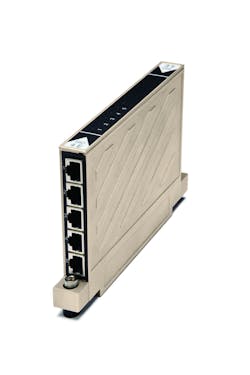In its latest move to extend the security and scalability of its Universal Control System, Bedrock Automation recently announced a software configurable 5-channel Ethernet I/O module.
The new SIO4.E Ethernet I/O module plugs into Bedrock’s unique pinless electromagnetic backplane to take advantage of the built-in cybersecurity of the company’s patented Black Fabric. Each of the module’s five I/O channels is independently software configurable, with the initial Ethernet protocols supported being: Ethernet IP, Modbus TCP, and OPC UA on TCP IP.
Of course, Ethernet modules are everywhere, but the interesting aspect of the Bedrock I/O has to do with its setup. In the traditional Purdue Enterprise Reference Model, Ethernet sits on a network switch at level 3 or 4 in the architectural hierarchy. But in Bedrock’s model, Ethernet is pulled down to level 0, onto a parallel high-performance I/O architecture that sits on the controller—which acts as a switch.
“There is an infinite number of reasons why Ethernet exists as a communication protocol and it exists in many different forms,” said Bedrock CTO Albert Rooyakkers. “That it now exists as part of the overall deterministic real-time control and I/O data structure is substantially cool if you think about it.”
What’s cool, Rooyakkers added, is that it all exists in one flat but extendible architecture. In addition, all channels deliver Power over Ethernet (PoE) while Bedrock’s computing horsepower and advanced electronics enable easier integration into real-time communications and control.
“The other benefit is that it is a secure device,” said Bedrock CEO Bob Honor. “We are acting as a quasi protection device for all other field devices, as we are a secure gate to Ethernet devices already installed.”
The Bedrock SIO4.E Ethernet I/O module is available at a cost of $2,000, about the same as a traditional Ethernet IP card. But unlike a typical Ethernet card, the five channel SIO4.E is cybersecure and software configurable for multiple protocols.
“You can set channel one to be Ethernet IP and channel two to Profinet, and you can have Rockwell and Siemens talking on the same network,” said Rooyakkers. In addition, it has more bandwidth, higher computing power and additional performance advantages, he said.
Support for Modbus TCP and OPC UA will be available in the next few months by way of firmware and software field updates. Profinet support is slated for second half of 2016.
Leaders relevant to this article:

